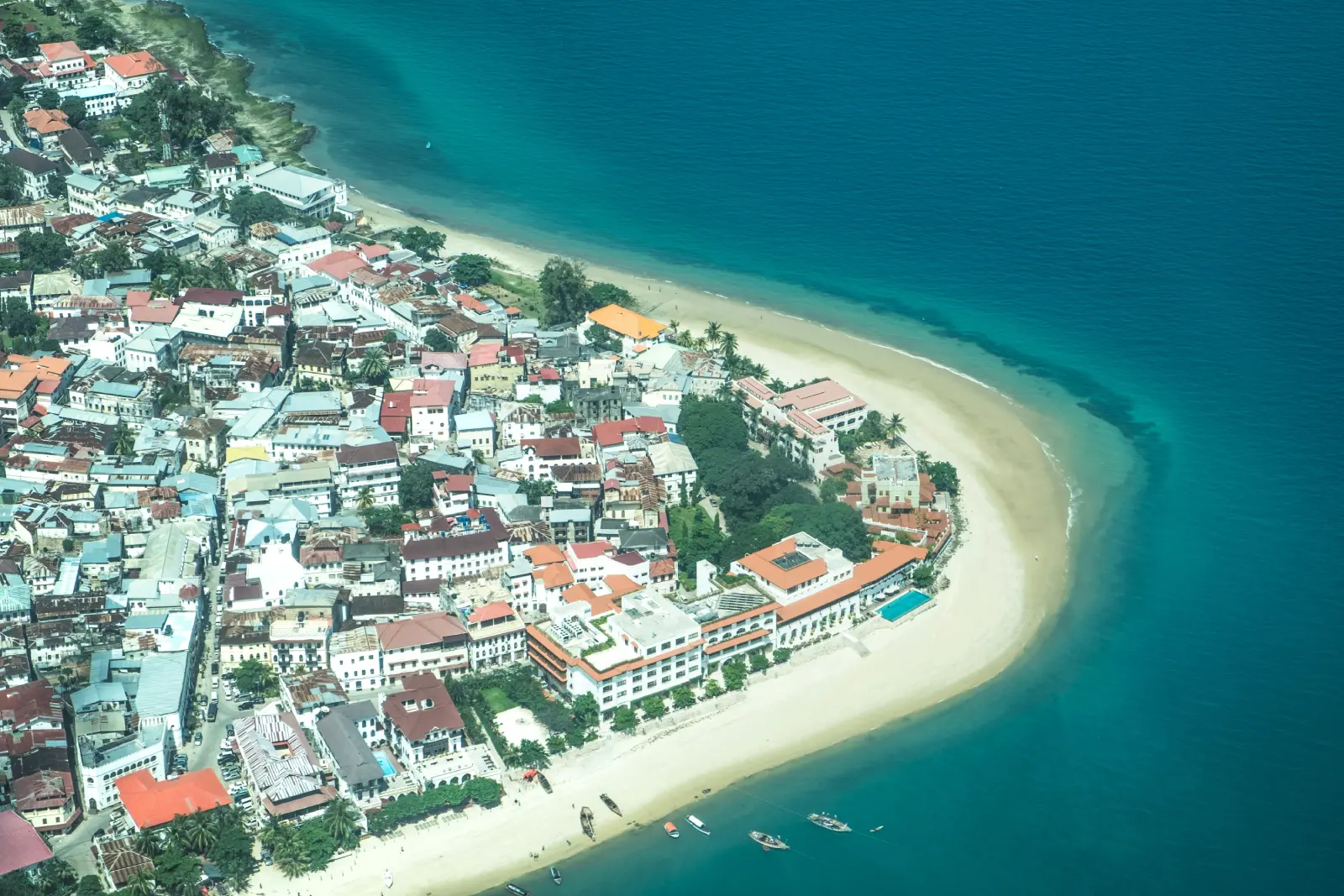Stone Town Zanzibar: 16 Awesome Things to Do, See, and Explore in Mji Mkongwe

Stone Town, or Mji Mkongwe, is more than just the historic center of Zanzibar—it’s where the island’s past and present collide in the most unforgettable way. Within its maze of coral stone alleyways and carved wooden doors lies a town shaped by centuries of trade, migration, and cultural exchange. You don’t just visit Stone Town—you step into it, breathe it in, and find yourself pulled into its rhythm.
This is one of the last remaining Swahili coastal cities, alongside Mombasa Old Town and Lamu where life continues much as it has for generations. Markets buzz with vendors shouting in Kiswahili, minarets echo the call to prayer five times a day, and the scent of cloves floats on the sea breeze. At every corner, Stone Town tells stories—from the rise of Omani sultans and the boom of the spice trade to the scars of the East African slave route.
Designated a UNESCO World Heritage Site, the town blends African, Arab, Indian, and European influences into its architecture, cuisine, language, and everyday life. You’ll find colonial balconies above Swahili doorways, Hindu temples beside mosques, and street food stalls next to 19th-century palaces.
If you’re planning a trip to Zanzibar and want to go beyond the beaches, this guide reveals the most essential things to do in Stone Town—from iconic landmarks and cultural activities to unforgettable flavors and everyday encounters that define this living, breathing heritage site.
Table of Contents
Admire the Famous Zanzibari Doors

Among the most iconic sights in Stone Town are the town’s ornately carved wooden doors—over 500 of them still stand today. These doors aren’t just entrances; they’re historical records, social markers, and artistic masterpieces rolled into one. Each design tells a story about the original inhabitants’ status, religion, profession, or origin.
- Indian-style doors: Arched on top, adorned with brass studs and floral motifs, often linked to Hindu symbolism.
- Arab-style doors: Rectangular with intricate geometric carvings and Quranic inscriptions.
- Swahili adaptations: Often a blend, with coastal elements and marine symbolism.
A guided door-walking tour is one of the more unique things to do in Stone Town, giving you insight into how this architectural heritage defines the city.
The Old Fort (Ngome Kongwe)
Built in the late 17th century by Omani Arabs to defend against the Portuguese, the Old Fort is Stone Town’s oldest standing structure. Its thick stone walls enclose an open-air amphitheater, a small market selling local crafts, and a cultural center hosting performances and festivals.
Today, it’s a hub for artistic expression, especially during the Zanzibar International Film Festival (ZIFF). If you’re in town during a festival, this is the place to experience Swahili music, dance, and film. Even on a quiet day, visiting the fort is among the top Stone Town activities, offering a vivid window into its martial and cultural past.
The House of Wonders (Beit al-Ajaib)

Once the most opulent building in East Africa, the House of Wonders is one of the most prominent things to see in Stone Town. Built by Sultan Barghash in 1883, it was the first building in Zanzibar to have electricity and an elevator—hence its name.
Although currently under renovation, its towering colonnades and seafront presence remain striking. Once reopened, it will house exhibits dedicated to Zanzibar’s maritime history and Swahili culture, making it an unmissable stop for anyone interested in the region’s rich heritage.
The Sultan’s Palace (Beit el-Sahel)
Next to the House of Wonders, the Sultan’s Palace—or Beit el-Sahel—stands as a quiet reminder of Zanzibar’s royal past. Overlooking the Indian Ocean, this 19th-century seafront residence once served as the power center for the Omani sultans who ruled the island at the height of its clove-fueled trade empire.
Now operating as a museum, the palace offers a glimpse into the lives of Zanzibar’s former rulers through original furnishings, ceremonial robes, portraits, and artifacts from daily court life. One of the most compelling exhibits is dedicated to Princess Sayyida Salme, whose memoirs provide a rare, personal look at royal life in 19th-century Stone Town—including her daring elopement and self-imposed exile in Europe.
While less grand than other landmarks, the Sultan’s Palace offers one of the most intimate and historically rich things to do in Stone Town, especially for travelers drawn to stories of royalty, rebellion, and Omani influence.
The Slave Market Memorial and Anglican Cathedral

Perhaps the most solemn and powerful of all Stone Town sights is the former slave market site, now home to the Anglican Cathedral of Christ Church. From the 17th to 19th centuries, Zanzibar was one of the largest slave-trading ports in East Africa. Here, men, women, and children were auctioned to the highest bidder.
Today, visitors can tour the underground holding chambers, barely tall enough to stand in, where slaves were shackled in pitch-dark conditions. Outside stands a moving bronze sculpture of five slaves in chains, set in a pit that mirrors the original market site.
The adjacent cathedral, built in the 1870s, stands as a symbol of abolition and hope. Visiting this site is one of the most important things to do in Stone Town—a reminder of both the island’s painful past and its progress.
Taste the Flavors of Forodhani Gardens Night Market

As the sun dips below the Indian Ocean horizon and the sky fades into fiery orange, Forodhani Gardens begins to stir with life. Located right along the waterfront in the heart of Stone Town, this lively park transforms every evening into the island’s most iconic open-air night market. Locals, travelers, and street vendors come together in a vibrant dance of flavor, aroma, and atmosphere that no visitor should miss.
Eating at Forodhani isn’t just grabbing a quick bite—it’s participating in a beloved ritual that reflects the island’s cultural blend. Influences from Swahili, Arab, Indian, and African cuisines fuse under the glow of bare bulbs strung across the square. Smoke rises from open grills, vendors shout their specials, and the rhythmic sound of the waves mixes with chatter and laughter. It’s one of the most social, affordable, and satisfying activities in Stone Town.
For those who travel with their tastebuds first, this is a paradise. Here’s what to sink your teeth into:
- Zanzibar pizza: Don’t let the name fool you—this is unlike any pizza you’ve had before. A thin dough is filled with egg, meat, vegetables, or banana and chocolate, folded into a square, then pan-fried until golden and crispy. Sweet or savory, it’s a must-try.
- Octopus skewers: Tender chunks of locally caught octopus grilled over open flames, often basted in a garlic or chili marinade. Served hot off the skewer with a squeeze of lemon or spicy sauce, it’s a standout favorite for seafood lovers.
- Urojo soup: Sometimes called Zanzibar mix, this tangy street food classic is a bowl of comfort. It combines boiled potatoes, crunchy bhajias, boiled eggs, fried cassava, and a ladle of spicy mango-coconut sauce. The textures and flavors make it an unforgettable culinary experience.
- Sugarcane juice: Watch it pressed before your eyes. Fresh sugarcane is juiced with a wedge of lime and a touch of ginger—refreshing, slightly sweet, and the perfect palate cleanser between snacks.
Beyond the food, the setting adds to the experience. Sit along the low sea wall as boats float by, or grab a plastic chair and chat with your vendor about where they get their octopus. Foodies will find themselves returning night after night, sampling different dishes and diving deeper into Zanzibar’s Swahili food culture.
Whether you’re a culinary explorer or simply hungry after a full day of sightseeing, eating at Forodhani Gardens is one of the most flavorful and immersive things to do in Stone Town.
The Freddie Mercury House
Queen’s legendary frontman Freddie Mercury was born in Stone Town in 1946, under the name Farrokh Bulsara, to Parsi Indian parents. Though his family later moved to India and then the UK, his early years were spent in this multicultural coastal town—surrounded by the sights, sounds, and rhythms that many believe influenced his dramatic stage presence.
His childhood home, located on Kenyatta Road, has since been converted into a small museum and boutique hotel. Inside, you’ll find photographs, newspaper clippings, and memorabilia documenting his early life and meteoric rise to fame. While the exhibits are modest, the visit offers a unique slice of local history with a global twist.
It’s a quick stop, but a fun and unexpected addition to your list of things to see in Stone Town, especially for music lovers and Queen fans looking to connect with one of rock’s most iconic voices in the place where his story began.
Darajani Market

This lively bazaar has been the center of local trade since the early 1900s. Darajani Market is chaotic, fragrant, colorful, and absolutely unfiltered. Inside, vendors sell everything from fish and spices to fresh produce, fabrics, and electronics.
Highlights include:
- The spice section: Cloves, cardamom, cinnamon, turmeric
- Textile stalls: Kanga, kitenge, and kikoi wraps
- Butcher counters and fish auctions
Walking through Darajani is one of the most authentic Stone Town experiences, offering a peek into the daily life of Zanzibaris.
The Hamamni Persian Baths
Built between 1870 and 1888 by Sultan Barghash, the Hamamni Baths were Zanzibar’s first public bathhouse. Though no longer operational, the site is open for tours. Inside, you’ll find arched corridors, steam rooms, and water channels that demonstrate advanced design influenced by Persian and Ottoman traditions.
This is one of the more underrated Stone Town sights, but a must for architecture and history lovers.
Take a Swahili Cooking Class
There’s no better way to understand a culture than by cooking its food. Many local chefs offer cooking classes where you’ll learn to prepare traditional dishes such as:
- Pilau rice with cloves and cardamom
- Fish curry in coconut milk
- Mango and tamarind chutney
- Hand-rolled chapati
Most classes start with a trip to the local market to buy ingredients, making this one of the most immersive and delicious Stone Town activities.
Watch a Taarab Music Performance
Taarab is the heartbeat of Swahili culture—a musical genre blending Arab melodies, African rhythms, and poetic Kiswahili lyrics. It’s a deeply emotional art form that has flourished in Zanzibar for centuries.
Catch a live performance at the Dhow Countries Music Academy, or during the Sauti za Busara Festival. Hearing Taarab live, especially in Stone Town, is a soul-stirring experience you won’t forget.
Sunset Dhow Cruise

One of the most magical things to do in Stone Town is to end your day with a sunset cruise on a traditional dhow. These wooden sailing boats, once used for trading across the Indian Ocean, now offer a romantic and peaceful way to see Stone Town from the water.
Expect:
- Gorgeous views of the Stone Town coastline
- Live Swahili music and light refreshments
- A front-row seat to the sun sinking into the sea
It’s the perfect way to unwind after a day of exploring.
Visit the Old Dispensary
The Old Dispensary, or Ithnashiri Dispensary, is a beautifully restored colonial building near the ferry terminal. Built in the late 19th century by an Indian merchant, its façade features stained glass windows, stucco decorations, and elaborate balconies.
Inside is a small museum, cultural exhibits, and often temporary art shows. It’s a quieter but architecturally rich stop among Stone Town’s sights.
Day Trips from Stone Town
Prison Island (Changuu)
Just 20 minutes by boat from Stone Town, Prison Island is one of the most popular short excursions—and for good reason. Originally intended as a prison for rebellious slaves and later used as a quarantine station during colonial times, the island’s crumbling structures still hint at its layered past.
Today, it’s best known for its sanctuary of Aldabra giant tortoises, some over 150 years old. Visitors can walk among them, feed them, and learn about ongoing conservation efforts. The island also offers crystal-clear waters for swimming and snorkeling, shaded walking trails, and peaceful picnic spots with views of the turquoise sea.
With its mix of history, wildlife, and laid-back island beauty, Prison Island is an easy, rewarding escape—and one of the most well-rounded activities near Stone Town.
Take a Journey Through Zanzibar’s Spice Farms
Just outside Stone Town, the lush inland farms of Zanzibar offer one of the most fragrant and immersive activities near Mji Mkongwe. Known for centuries as the Spice Island, Zanzibar was once the world’s leading producer of cloves—and today, guided tours through family-run spice farms offer a hands-on way to experience that legacy.
You’ll walk among rows of cinnamon trees, cardamom pods, vanilla vines, turmeric roots, and clove blossoms, encouraged to smell, touch, and even taste as you go. Guides bring the experience to life with local folklore, plant uses in Swahili culture, and impromptu crown-weaving from banana leaves.
Most spice tours wrap up with a home-cooked meal flavored with the very spices you’ve just explored—making this one of the most sensory-rich and flavorful things to do near Stone Town.
Where to Stay in Stone Town
Emerson on Hurumzi
A restored merchant’s mansion turned boutique hotel, Emerson on Hurumzi is Stone Town at its most atmospheric. Rooms are dramatic—high Zanzibari beds, stained-glass windows, silk-draped interiors—and every inch feels like a Swahili time capsule. The rooftop restaurant is iconic: candlelit, panoramic, and backed by live taarab music. For travelers chasing the romance of history, this is the spot.
Maru Maru Hotel
Modern comfort in a prime location. Maru Maru offers clean, spacious rooms with reliable amenities, but the real showstopper is the rooftop: a bar, a pool, and uninterrupted views of the sea and town skyline. It’s stylish without losing local flair—ideal for mid-range travelers who want convenience with atmosphere.
Dhow Palace Hotel
An old-world hotel with carved wooden staircases, antique furniture, and inner courtyards that echo with the whispers of the past. Dhow Palace is charming, affordable, and full of character. It’s not flashy, but it’s authentic—perfect for travelers who want a heritage stay without a luxury price tag.
Lost & Found Hostel
Easily the best hostel in Stone Town. Clean dorms, good security, fast Wi-Fi, and a social vibe that makes it easy to meet other travelers. Located just a few minutes from the ferry terminal, it’s ideal for solo backpackers, short stays, or anyone looking to keep costs low without sacrificing location.
Travel Tips for Visiting Stone Town

A visit to Stone Town is unlike anywhere else in East Africa, and a few simple tips can help you navigate its rhythm with ease and respect.
Dress modestly
As a predominantly Muslim town, modest clothing is expected, especially in local neighborhoods, mosques, and markets. Covering shoulders and knees is appreciated for all genders. Lightweight, breathable fabrics will keep you comfortable in the tropical heat while showing cultural awareness—an important part of traveling responsibly in Zanzibar.
Be mindful of prayer times
You’ll hear the call to prayer echoing from Stone Town’s many minarets five times a day. During these times—particularly midday on Fridays—avoid loud behavior near mosques and steer clear of entrances. If you’re visiting during Ramadan, expect a slower pace and more subdued atmosphere during daylight hours.
Stay alert in crowded areas
Stone Town is generally very safe, especially for tourists, but like any busy town center, crowded markets and ferry terminals can attract petty theft. Keep an eye on your belongings, avoid flashy jewelry, and carry only what you need for the day.
Hire a local guide
Wandering aimlessly is part of the charm, but a knowledgeable local guide can bring Stone Town’s layered history to life. From architectural details and hidden courtyards to untold stories of sultans and spice traders, guided walks are one of the most enriching Stone Town activities—and a way to support local livelihoods.
Bring cash
While some hotels and larger restaurants accept cards, most shops, food stalls, and transport providers operate on cash only. Carry Tanzanian shillings in small denominations and expect to bargain in markets—it’s all part of the experience.
Final Thoughts: Let Stone Town Enchant You
Stone Town isn’t just a place to visit—it’s a place that stays with you. It’s in the sound of the call to prayer echoing through coral alleys, the scent of spices rising from street grills, and the worn texture of ancient doorways beneath your fingertips. It’s a city of contrasts: vibrant yet crumbling, historic yet alive, chaotic yet deeply soulful.
From exploring slave chambers and sultans’ palaces to tasting Zanzibar pizza under the stars and sailing past minarets on a sunset dhow, the best things to do in Stone Town go beyond tourism. They immerse you in a culture that’s been shaped over centuries by trade, hardship, and resilience. A culture that still pulses through every market, melody, and meal.
If you’re drawn to places with stories etched into every wall and voices carried in the sea breeze, Stone Town will speak to you. All you have to do is walk its streets, open your senses, and let it.
Because in the end, Stone Town isn’t just a destination—it’s an experience. One that roots itself in memory and stays long after your footprints in the sand have faded.
Let Stone Town speak to you. Let it slow you down. Let it change the way you travel.






